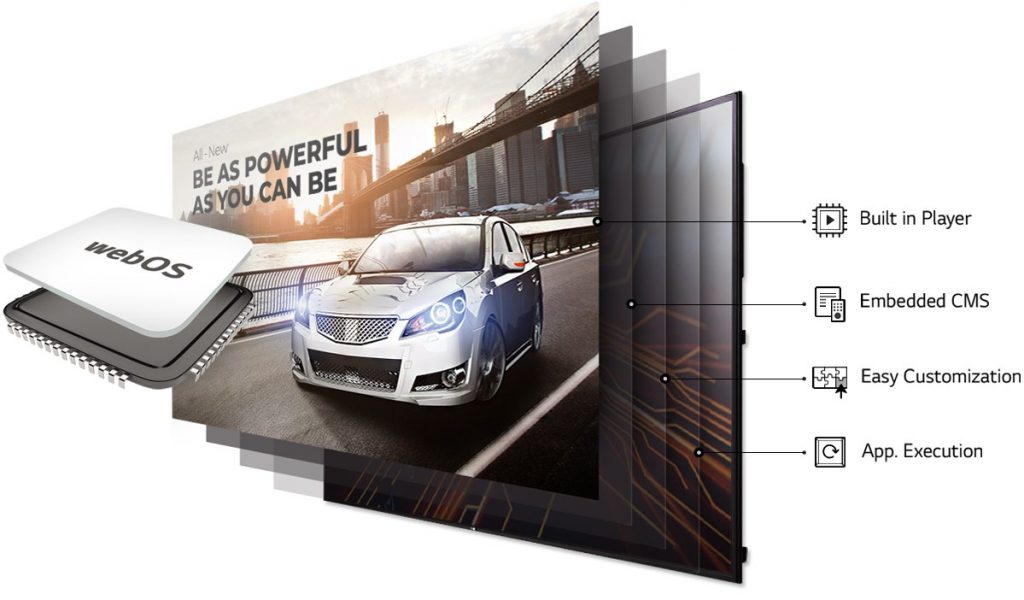 Guest Post: Curtis Campbell, Hughes
Guest Post: Curtis Campbell, Hughes
Virtually everywhere we look, we see divisions. Be it politics, how to raise children, dogs versus cats, there never seems to be a winner-take-all argument. And digital signage technology is no different. For a few years now, signage buyers have been presented with an alternative to external digital signage players – namely SoC (System On Chip) and digital signage running on SmartTV displays.
Those technology providers & vendors deeply entrenched in the traditional will consistently, readily, and easily discount SoC as “less powerful.” To clarify, those buyers are looking for expansive UHD / 4K video walls, where traditional signage players are daisy-chained (a.k.a. networked together) to create an large, immersive video experience.
UHD / 4K video walls, where traditional signage players are daisy-chained (a.k.a. networked together) to create an large, immersive video experience.
And let’s not forget interactive, HD touchscreen kiosks that “require the immense processing power of an external digital media player.”
And again, those entrenched in this way of thinking, will state the list goes on and on.
But let’s pause for a second, and think. Why do some believe that a SoC/Smart Signage solution can’t perform in those applications named above? And what about the virtually limitless other applications for digital signage? While three years ago, I might have sided with external players, I am definitely leaning in the opposite direction. Why? Because the technology continues to evolve, the costs keep decreasing, and the list of applications grows longer every day. But don’t worry. I will explain myself.
Dollars and Sense
Let’s start first with the financial side of SoC / smart signage.
Right out of the gate, with the price of Smart HD displays decreasing every day, add to that notion that removing an external signage player instantly removes what can be a several hundred dollar signage player. Instantly, you are now left with just a SmartTV versus a screen plus a player. Why does this matter? One, reduced cost. Two, reduced infrastructure (meaning all you need is a screen and an internet connection. Add to this fact that Smart screens have integrated WiFi, required infrastructure is further simplified. Additionally, with one less device to support, you have less maintenance costs, fewer chances for failure, and typically one vendor’s throat to choke. This immediately translates to a significantly reduced TCO (total cost of ownership).
But my affinity for SoC/smart signage runs deeper than the balance sheet. Looking back up to the top of this post, SoC’s inability to display an expansive video wall is no longer a solid argument. Because at the end of the day, it comes down to the brains behind the screen. If the content management system (a.k.a. the brains behind the display) is capable of splitting the image across multiple panels, in most cases, this becomes a mute point. What about touchscreen kiosks?
Since the inception of SoC displays, a number of 3rd party technology providers have brought touchscreen overlays to market, enabling virtually any screen to be made a touchscreen. And today, with LG and Samsung both offering smart signage solutions that feature integrated touch, the simplicity argument surfaces again.
Easy Management
And now, let’s look at the management aspect of SoC / Smart signage. When a traditional media player is deployed, setting up the display and tinkering with settings, etc., typically requires a keyboard and mouse. But with SoC / Smart signage solutions, a few vendors have stepped up to leverage the screen’s I/R remote. Now, users can simply pick up the remote, modify settings, increase volume, access additional features, etc. And then, for those SoC / Smart signage solutions that offer live TV integration, changing channels is even easier. Sure, everyone has experienced losing a remote in the couch, but with yet another reduction in the number of devices, your simplicity increases.
And to my final point, what about the limitless other applications that are made more simple through the use of SoC/Smart signage? Waiting room signage, conference / meeting room signage, employee-facing / corporate comms signage above time clocks, menu boards / promotional signage in already crowded grocery and c-stores? And what about signage mounted from the ceiling or ad hoc end cap displays in a retail store? All of these deployments become easier as less technology is required.
Add back to this notion the reduction of prices of smart displays, virtually any business, which includes small businesses, dusty manufacturing / production / shop floors, crowded kitchens, and a million other environments / businesses can all leverage reduced complexity to ultimately create better customer experiences.
I am sure there will be some that will pick apart this argument, and still tell me that I am wrong. But I’ve seen enough, and continue to see the technology improve, to take a big step on the other side of the fence. This may be a little “tongue-in-cheek,” but I believe that innovation sides with SoC / smart signage.
Let’s not forget what happened to Kodak – a huge brand that faded away when it failed to innovate and adjust with the times.
